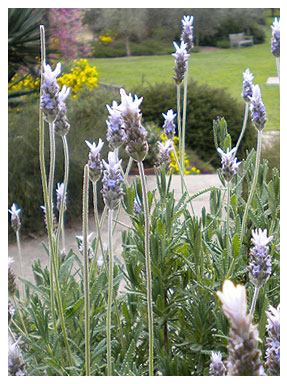








 |
|---|
| Lavandula sp. (French lavender) stands tall among the ornamentals in the Mediterranean garden at the Royal Botanic Gardens, Kew (UK). Lavandula species are grown primarily for their essential oil, which is useful as a flavorant, perfume, antiseptic, and medicine. Lavenders are also used in regional cuisines as culinary herbs and are widely cultivated around the world. © 2009 Grant Godden. |
Lamiaceae (mint family) is the sixth largest flowering plant family and a source of many familiar mint and culinary flavors enjoyed by people worldwide. Many members of the mint family produce so-called secondary metabolites, which are byproducts of plant chemistry that impart the familiar flavors of peppermint or spearmint in herbal teas or savory culinary seasoning from oregano, basil, lavender and other herbs. Human appreciation and consumption of these botanical compounds supports a growing agronomic industry, with the market for peppermint and spearmint oil alone worth over $200 million in 2011 (USDA); and yet it is unclear how and why the underlying chemistry of these compounds evolved in the family.
Lamiaceae have high degree of chemical diversity. The major subfamilies within the Lamiaceae, for example Lamioideae and Nepetoideae, can be readily distinguished morphologically and also show qualitative and quantitative differences in the synthesis of two key specialized compounds, iridoids and volatile monoterpenoids. These compounds play an essential role in plant reproduction, defense, and signaling. They are also the source of mint and other herbal flavors for human consumption and aromatic compounds used in many perfumes.
The primary aim of the Mint Genome Project is to understand the chemical pathways required to synthesize secondary metabolites using genome sequencing and to identify all the relevant factors produced in each species. By comparing the resulting large datasets across family members, the project will clarify how such chemical processes evolved in Lamiaceae and in plants in general.
The Mint Genome Project integrates genomic, metabolite, phylogenetic, and functional datasets to investigate the evolution of the monoterpene and iridoid biosynthetic pathways in Lamiaceae. Because the project is interdisciplinary, we will work collaboratively and leverage our collective expertise in biochemistry, genomics, genetics and evolutionary biology (see participants for details). We will also provide experiences for high school, undergraduate, and graduate students, who will train at the frontiers of science and participate in cutting edge genomics research that links directly to products of economic value. Moreover, through collaboration with the Michigan State University 4-H Children's Gardens and the Florida Museum of Natural History, we will offer informative displays and tours so the public can become citizen scientists as they learn about the evolution and underlying "flavor" chemistry of the familiar and much appreciated mint family (see the outreach section of this website for details).
All resources from the Mint Genome Project, including genome and transcriptome sequences and metabolite information will be publicly available on this website, as well through publications, the NCBI sequence archives, and the Dryad Digital Repository. To learn more about the project, explore the links in the menu provided in the upper right corner of this page.
| Overview |
| Project Description |
| Taxonomic Sampling |
© 2015 University of Georgia
Buell Lab | Department of Crop and Soil Sciences, 111 Riverbend Rd., Athens, GA 30602 | Tel. (706) 542-6227